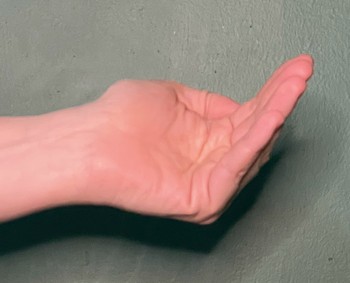Nṛtyavinōda of Mānasôllāsa: Asaṃyuta Hasta (Single Hand Gestures)
1126 CE - 1234 CE - by Someśvara III
Asaṃyuta Hasta - Single Hand Gestures
Nṛtyavinōda of Mānasôllāsa - Language: Sanskrit
This a great text for everything. It's written in the Western Chalukyan dynasty which is in modern day Karnataka and Andhra Pradesh. This a truly broad and yet detailed text covering a number of elements of life at this time. One volume of this set of tomes is the Nṛtyavinōda. It returns to the same type of format of the Natya Sastra in that lists sets of movements of each part of the body with descriptions of how to execute them and what they mean.
Descriptions and Meanings
4:1158-11161
Patāka: The thumb is bent to touch the root of the forefinger and the rest of the fingers are extended and kept close together.
4:1158-11161
This Hasta when done with the fingers together is used to depict cutting, pride, patting the arm, happiness and cutting a creeper. Patāka Hasta with the fingers separated is used to depict moving the hands through the hair, pushing, falling of flames and giving blessings. While depicting lightening and forbidding the fingers are moved and point upwards. While depicting rain and showering of flowers, the Hasta faces downwards,
4:1199-1202
Muṣṭi: The fingers touch the palm and the thumb is placed on them; alternately, the thumb is placed over which the fingers are closed.
4:1199-1202
This Hasta is used to depict running, beating and holding a sword or a bow. The second type is used to depict milking, wrestling and beating the sides,
4:1204-1206
Kapittha: The forefinger of the Ṡkhara Hasta is bent and pressed by the thumb. It also projects outside a little.
4:1204-1206
This Hasta is used to depict affirmation, releasing s disc (wheel) and discharging weapons after meditating (by placing on the forehead).
4:1208-1211
Sūcimukha The forefinger of the Musti Hasta is extended. This Hasta is of three types: bent (vakra), shaking (kampra) and stretched (prasarita).
4:1208-1211
To depict using weapons and forbidding Vakra Sūcimukha is used. To depict directing and threatening Prasarita Sucimukha is used. To depict earring, turning of a wheel, good words and swinging Kampra Sucimukha is used.
4:1174-1176
Padmakōṡa: All fingers including the thumb are bent and are kept separate. The Hasta can be done facing upwards or downwards.
4:1174-1176
This Hasta is used to depict taking the Kapittha or Bilva fruit, showing the hand to children and a downcast face
4:1166-1168
Ahiphaṇa: The palm of the Patāka Hasta is hollowed.
4:1166-1168
This Hasta is used to depict pouring, drinking or offering of holy water. When facing downwards it is used to depict waving movement, dwarfs and the like. It is held facing upwards to depict blessing, appeasing and the movements of snakes,
4:1172-1174
Mṛgaṡirshā: The little finger and the thumb of the Sarpasīrṣa Hasta are extended.
4:1172-1174
When facing downwards this Hasta is used to depict wiping off sweat, beckoning and shading the eyes from the sun, When facing upwards it is used to depict colouring the face and throwing the dice,
4:1180-1182
Kāṅgūla The thumb, forefinger and middle finger are separated and kept in a triangular position. The ring finger is bent and the little finger is kept straight.
4:1180-1182
This Hasta is used to depict different types of fruits, small quantities and caressing the chin of children,
4:1188-1190
Haṁsamukha The little finger of the Mukula Hasta is raised upwards and the ring finger is bent.
4:1188-1190
This Hasta when moved slightly is used to depict smoothness, smallness and softness. To depict the act of smelling flowers the Hasta is kept steady,
4:1192-1196
Sandaṁṡa The forefinger and the thumb of the Arala Hasta meet at the tip and the palm is slightly hollowed. The Hasta is done in three different ways: towards the front (Agraja), towards the face (Mukhaja) and towards the side (Parsvaja).
4:1192-1196
This Hasta when done facing the front (Agra; a Sandaṁṡa Hasta) is used to depict removing thorns, plucking small flowers and rebuking rudely.
This Hasta when done facing the side (Parsvaja Sandaṁṡa Hasta) is used to depict rubbing the sacred thread, powdering things like camphor and taking betel leaf.
This Hasta when done towards the face (Mukhaja Sandaṁṡa Hasta) is used to depict painting, drawing the eyebrows, stringing beads and decorating the eyelashes.
4:1186-1188
Mukula: All the finger tips including that of the thumb touch each other to form a plantain flower.
4:1186-1188
This Hasta when held obliquely and facing upwards is used to depict counting of gold coins. It is held facing downwards to depict prayer and making offerings to the Gods,
4:1197-1199
Tāmraçūḍa: The forefinger of the Mukula Hasta is raised up and bent. The little finger and the ring finger touch the palm.
4:1197-1199
This Hasta is used to depict inspiring confidence in children, hurrying up, snapping fingers, in war, yawning and kings.
4:1184-1186
Urṇanābha: The fingers of the Padmakōṡa Hasta including the thumb are bent.
4:1184-1186
This Hasta is used to depict taking objects like gold, a lion, tiger and scratching the head,























